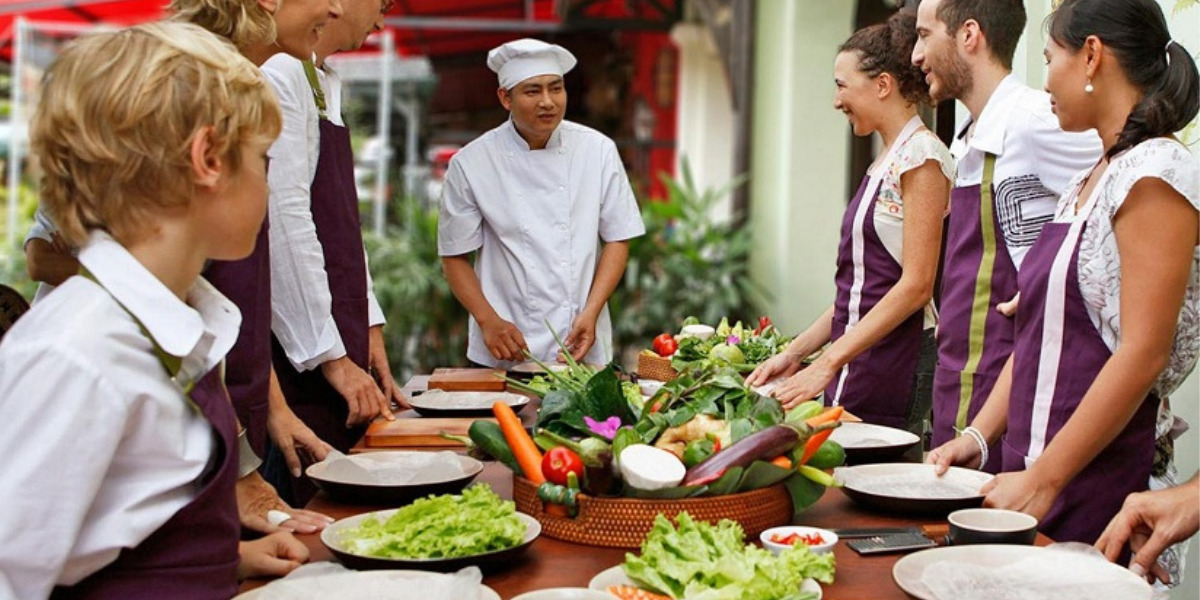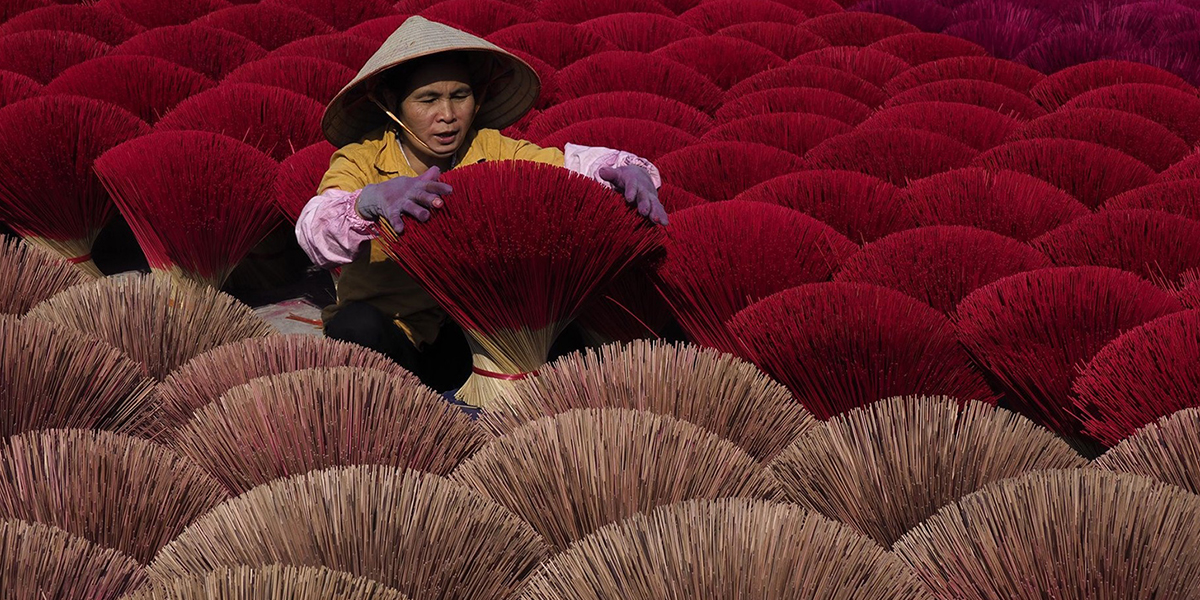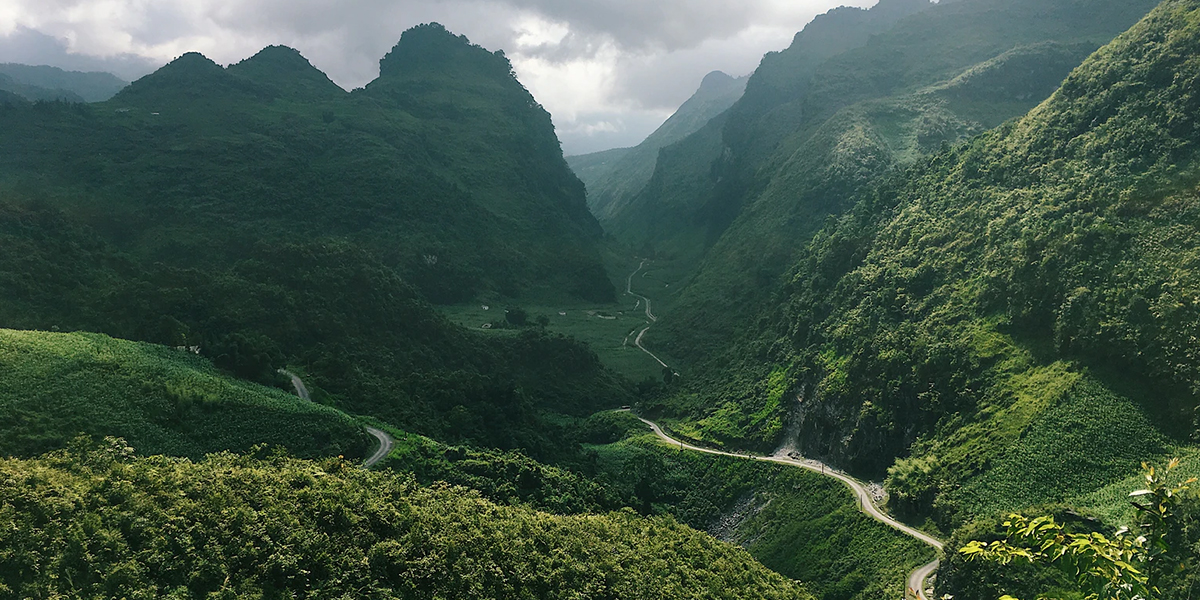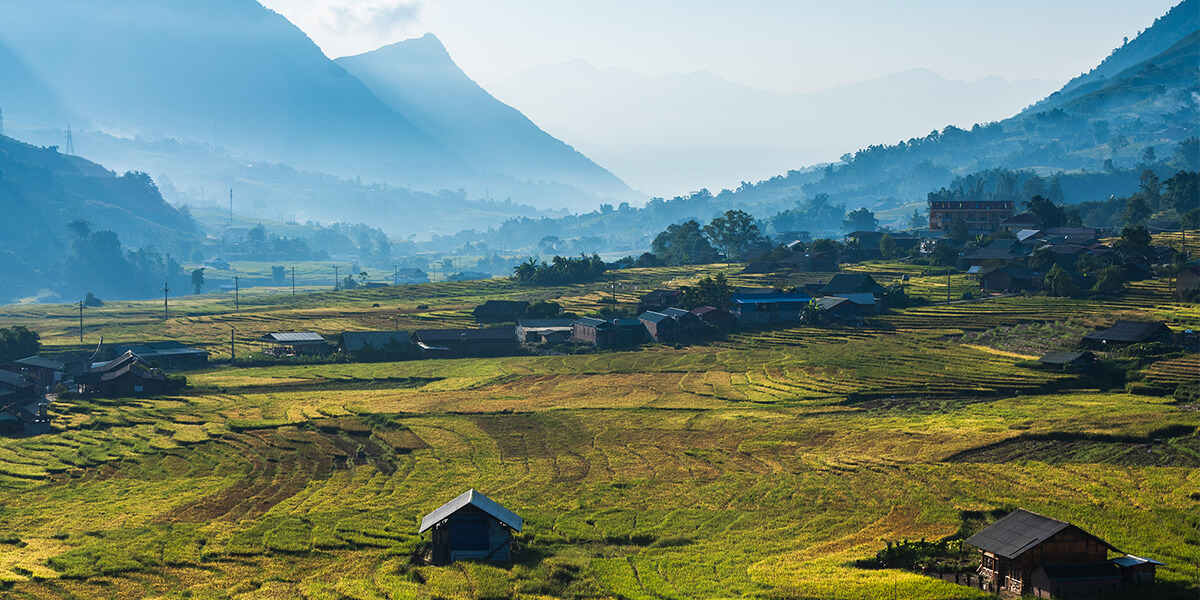Each traditional dance in Vietnam is a beautiful aspect of the country’s culture. In Vietnam, a country well known for its unique cultural identity, although there has not been a dance claimed as the national dance, there are numerous dances that are attached to the history and customs of different areas or groups of people. The following are top 10 best traditional dances that you should be known to get more understanding about cultural tourism in Vietnam.
Sap dance - top 10 Vietnamese traditional dances

Sap dance Originating from daily works - Source: gialai
The Sap dance is a unique folk dance of the Thai people in the Northwest of Vietnam on happy occasions, or during spring festivals. To organize this traditional dance of Vietnam, folks prepare two large bamboo trees, strong and long enough to be the bases, along with many pairs of smaller bamboos. The two main bamboos are placed horizontally, far from each other at a distance enough to hold the two ends of the smaller. The smaller bamboos are placed vertically and parallel to each other to form a net.
The participants are usually boys and girls in villages and are divided into two groups, one clapping bamboo while the other jumping the bamboo. The people who clap the bamboo must be steady, their speed is slow at first but can be gradually raised, making the jumps more difficult, which can hardly be seen in other Vietnamese traditional dances.
The dancers, in turn, jump into the frame, each holding a long scarf when bouncing and winding around. The movements are light, flexible, at times rapidly changing horizontally, vertically, diagonally, and round, and must be in the right rhythm so that when the two bamboos collide, the dancers don’t get stuck. The Sap dance performance is not only an occasion for the villagers to gather and have fun, but also the chance for boys and girls to get to know each other, and fall in love.
Khen dance
Khen is a unique musical instrument that plays an important role in the spiritual life of the H'Mong people in the Northern mountainous area. Khen blowing seems to have become a method for the H'Mong people to convey, express their thoughts and aspirations, and communicate with spiritual entities.

One of the impressive Vietnamese traditional dances - Source: svhttdl.dienbien
At a wedding, the sound of the Khen is like a message from parents to their daughter when she moves to her husband's house. In funeral rites, the Khen is blown to show mercy and nostalgia for the deceased.
This traditional dance of Vietnam is also a dance prop, and a good Khen player must know how to dance with the Khen, skillfully combining movements to both play and dance. Khen dancers with shrugs, swings, turns, or hugs and rolls on the ground create beautiful choreography. The faster a person dances, the more skilled he is. Dance and sound blend together in the art of Khen dance, allowing viewers to enjoy the diverse rhythms and variations of the Khen sound while observing the flexible and rhythmic image of the dancers. Khen dance is to compete, express the love between the couple and show the willpower and energy of the H'Mong man.
Xoe dance - one of the Vietnamese traditional dances

Xoe dance of Thai people in Northern Vietnam - Source: dienbien.gov
Xoe dancing is the result of artistic creation derived from the labor of the Thai community to meet the needs of their own cultural enjoyment. This traditional dance in Vietnam is collective, with high community exchange, so the number of participants is not limited, regardless of young and old, boys and girls, people in the village or other villagers, and even visitors can participate. Xoe dancing usually takes place in spacious places. The larger the crowd, the wider the circle.
In places where it is not possible to widen the spread more, people often actively split the spread into 2 or 3 concentric circles. The center of the circles is usually determined with a jar of wine or fire. Then, a circle moves clockwise, then the other moves in the opposite direction. After days of hard work, immersing in the art of spreading not only helps each person find relaxation and excitement but also makes village and social relationships more cohesive.
As one of the Vietnamese traditional dances, the Xoe dance has become a tool connecting the community, a symbol of solidarity, the crystallization of life experiences and creative thinking in the daily life of Thai people; a bridge to help tourists better understand the lives of people in the Northwest and contribute to enriching Vietnamese culture and Vietnam folk dance art.
Cham dance of Cham people

Cham dance is a traditional dance of Vietnam - Source: baodantoc
Champa was an ancient kingdom in Central Vietnam. When the nation collapsed, Cham people migrated to different regions of Vietnam. Currently, the community of Cham folk concentrates mainly in Ninh Thuan Province, Tay Ninh Province, Dong Nai Province, Ho Chi Minh City, Southwest Binh Thuan Province, and Northwest Phu Yen Province,...
Cham dance is important in the cultural and spiritual life of the Cham people and is associated with big festivals such as Rija Nùgar, Kate, Rija Praung,... which are occasions for Cham people to show their remembrance for those who built the country or worship one or several kings deified. Like other Vietnamese traditional dances, accompanying the Cham dance are traditional ethnic instruments. Some of them are the Ginang drum, Baranung drum, Ceng (gong), Xaranai trumpet, Gron (rattle), Kanhi,... and the main is still Ginang because it has a strong and eloquent sound that is not only suitable for festivals but also reflects the personality of the Cham people.
Cham dance always includes two distinct parts, corresponding to different contents, properties, and meanings: one is in service of religious beliefs in religious ceremonies, and the other is in daily life, mainly to meet the entertainment needs in community activities. Formal dances are often associated with images of gods, praying for a peaceful life,... while festival dances are often related to objects or living habits of the people. Three popular folk dances are peacock dance (also known as fan dance), water team dance, and towel dance.
Hue royal court dance - top 10 Vietnamese traditional dances

Hue royal court dance is a traditional dance in Vietnam - Source: nld
Hue used to be the convergence of the artistic quintessence of the whole of Vietnam. Hue royal dance is one of the unique heritage of the ancient Hue culture. Since Hue royal court music was recognized by UNESCO as a Representative Intangible Cultural Heritage of Humanity, royal dance has also been "enthroned".
Throughout the long-term history of Vietnam, each reign had elegant dances performed in the court to make fun of the king and mandarins. These dances were passed down and developed from dynasty to dynasty. And, the one referred to as the heyday of the royal court is the Nguyen Dynasty (1802 - 1945).
Hue court dance is upgraded from folk dance. However, the former requires professionalism in every aspect. A royal court performance often features many scenes, each scene requires a large number of dancers, mostly beautiful maids. These dancers wear colorful and elegant costumes, meticulous makeup, and hair. Expected to meet higher standards than other Vietnamese traditional dances, each movement in Hue royal court dance must be conducted smoothly and there is no allowance for a mistake. It is essential that the dance is coupled with music. Therefore, the dancers of Hue Royal Court must be very talented because they were required to sing well while dancing beautifully.
If you want to admire this traditional dance of Vietnam, you should access the Hue Royal Court Traditional Art Oper located in the Imperial city of Hue.
Xuan Pha folk dance

Xuan Pha folk dance in Xuan Pha village, Thanh Hoa province - Source: dantri
The exact birthdate of the Xuan Pha folk dance is still a myth. It is believed to be dated back from a long long time ago. Because the dance recreates the scene of 5 ancient adjacent countries bringing offers to treat the King of Vietnam at the time, it consists of 5 performances representing the culture and tradition of these countries, namely Hoa Lang, Tu Huan, Ai Lao, Ngo Quoc, and Xiem Thanh.
Like some other Vietnamese traditional dances, the art of Xuan Pha folk dance is the combination of playing, singing, and dancing, of which dancing is the most important. All performances must follow strict rules and scenarios. The dancers are expected to use hand gestures, leg gestures, and props such as flags, paper fans, spears,... The signature of this traditional dance is strong gestures like shrugging, head shaking, body moving, little jumping…
Every year, on the 9th and 10th of the February lunar month, the people of Xuan Pha village, Tho Xuan district gather together for the village festival.
Lion dance

Lion dance - Source: dkn
During major holidays in Vietnam such as Lunar New Year, villages' god festival, Mid-Autumn Festival, or at weddings, opening ceremonies,... you often see lion dance teams performing. The dance is attached to three features including a unicorn, a lion, and a dragon which all symbolize luck, happiness, and prosperity. And currently, the lion dance has become one of the Vietnamese traditional dances as well as a familiar street folk art that is loved by many people.
Depending on the meaning and atmosphere of each festival, lion dance teams will perform suitable songs. Each part can usually be danced separately or can also be combined with a lion dance with a unicorn, a lion dance with a dragon,... Mr. Dia is also an indispensable part of this traditional dance of Vietnam. He actually is an earth god who is in charge of protecting the safe and sound life of a locality in the Vietnamese perspective. In the lion dance, Mr. Dia often appears next to the lion group representing the affection between humans and animals. In addition, an important factor contributing to the impressive performance is the drum sound with different fast and slow tempos.
Gong dance - one of the Vietnamese traditional dances recognized by UNESCO
Following Hue royal court music, on November 25, 2005, the Gong cultural space in the Central Highlands was recognized by UNESCO as a masterpiece of the intangible heritage of humanity. Gongs in the Central Highlands are a type of culture spanning five provinces: Kon Tum, Gia Lai, Dak Lak, Dak Nong, and Lam Dong owned by ethnic groups: Bana, Xe Dang, Mnong, Co Ho, Rom, Ede, Gia Rai... The gong is a musical instrument made of copper alloy, sometimes mixed with silver or black copper. The sound of gongs closely follows the entire human life of the ethnic people here.
This traditional dance in Vietnam is one of the4 indispensable elements of every festival in the Central Highlands. Dancers often move their bodies to the beat of gongs with short and rhythmic steps and coordinate between bending and stretching their legs and arms, while bouncing and swaying their bodies.

Gong dance is one of the unique Vietnamese traditional dances - Source: macramevietnam
In the lively sound of gongs, the rhythmic and flexible gong dances performed by boys and girls draw everyone in. The dance formation usually moves in a counter-clockwise circle, around the tree in the yard, or the area in front of the maloca. Each movement directly or indirectly describes and recreates the daily life and production activities of people: from walking, standing, burning, playing, chopping, and pruning, even the nuances of love and anger.
Once mentioning Gong dance, it is essential to talk about the Gongs festival. The festival often takes place in a couple of days but there is no fixed time it is held. In general, it is often during the period from March to December. On this occasion, when the sound of Gong emits, residents in the Central Highland flock around the fire and the jar of straw liquor, jump, dance and sing happily together.
Conical hat dance

Conical hat dance of the Mekong Delta - Source: congtysukiengiare
When it comes to the list of Vietnamese traditional dances, it fails not to mention the Conical hat dance. Enjoying the performance, you are taken on a trip around the Mekong Delta Vietnam - a rich land with interlaced rivers. This land also represents a peaceful life and affectionate people. This type of traditional dance of Vietnam, therefore, also brings joy and excitement in accordance with this spirit. The dance can introduce you to the scene of Phung Hiep floating market, the place where thousands of small boats come and go, the bamboo monkey bridges connecting the two banks of the creeks or remind you of the bustling markets of Sa Dec City, Soc Trang Province, Can Tho City with colorful fruits...
When dancing, the dancers wear Ba Ba, the traditional Southern dress. This is a short, simple shirt, but pretty suitable for the graceful body of Southern women. Paired with the Ba Ba is a Vietnamese conical hat, a simple, very light, and very common item used by Vietnamese people. This is one of the Vietnamese traditional dances with these props imbued with tradition, so its background music must be those with heroic melodies, imparting the national spirit and the burning love for the country. It is no wonder that the conical hat dance represents the cultural identity of the people in the South in particular and Vietnamese people in general.
Bell dance

Bell dance of Dao ethnic group - Source: vov
Bell dance is one of the main and unique dances in the sacred rituals of the Dzao people in Hoa Binh province. Bell dancing usually requires the participation of both men and women, at least 3 pairs, the more the merrier. When dancing, the dancer holds a thin bamboo stick with their left hand and a bell with their right hand to count the beat according to the guidance of the conductor. While dancing, they sing old songs, simulating the process of making a living on the new land, getting married, and giving birth to children in each family. This is one of few Vietnamese traditional dances with a small bronze bell as the main prop combined with some auxiliary props such as drums, erhu, flute, etc. to form rhythmic but vibrant and strong music, bringing the footsteps of Dzao boys and girls to the dance.
For the Dzao, cultural beliefs and traditional dances are deeply ingrained in their blood. No one fails to know how to dance bells. Since community tourism developed, the province started to welcome international tourists, bell dance is performed regularly to serve tourists’ observance, not just during the holidays like Tet or big day of family, or clan as before. If you want to admire this beautiful traditional dance of Vietnam, the best place to come is Sung hamlet in Cao Son commune, Da Bac district, Hoa Binh province.
Each traditional dance in Vietnam is a collection of quintessence in the culture that folks want to maintain and pass on to the next generations. It is to say that contemplating Vietnamese traditional dances is a great opportunity for you to broaden your understanding of different parts of Vietnam.







.jpg) — Ha Bich
— Ha Bich





































